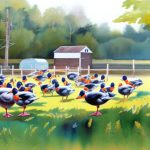Heavy duck breeds are a popular choice for many poultry enthusiasts due to their large size, gentle nature, and excellent egg-laying abilities. These ducks are known for their robust build, making them ideal for meat production, as well as their ability to lay a good number of eggs. Heavy duck breeds are also valued for their calm and friendly temperament, making them a great addition to any backyard flock. These ducks are often raised for both meat and egg production, making them a versatile choice for small-scale farmers and homesteaders.
Heavy duck breeds are known for their distinctive appearance, with broad bodies, thick necks, and strong legs. They are larger and heavier than other duck breeds, with males typically weighing between 9-12 pounds and females weighing between 8-10 pounds. Their large size makes them an excellent choice for meat production, as they yield a good amount of meat compared to smaller duck breeds. In addition to their size, heavy duck breeds are also known for their excellent egg-laying abilities, with females laying an average of 150-200 eggs per year. This combination of size and productivity makes heavy duck breeds a popular choice for those looking to raise ducks for both meat and eggs.
Key Takeaways
- Heavy duck breeds are known for their large size and weight, making them popular for meat production and exhibition.
- Characteristics of heavy duck breeds include a broad body, thick plumage, and a calm and docile temperament.
- Popular heavy duck breeds include the Pekin, Muscovy, Rouen, Aylesbury, and Cayuga.
- Housing and care for heavy duck breeds should include a spacious and secure enclosure with access to water for swimming and grooming.
- Feeding and nutrition for heavy duck breeds should consist of a balanced diet of commercial duck feed, fresh greens, and access to clean water.
Characteristics of Heavy Duck Breeds
Heavy duck breeds are known for their distinctive characteristics that set them apart from other duck breeds. One of the most notable features of heavy duck breeds is their large size and robust build. These ducks have broad bodies, thick necks, and strong legs, giving them a solid and sturdy appearance. Their large size makes them an excellent choice for meat production, as they yield a good amount of meat compared to smaller duck breeds. In addition to their size, heavy duck breeds are also known for their excellent egg-laying abilities, with females laying an average of 150-200 eggs per year.
Another characteristic of heavy duck breeds is their calm and friendly temperament. These ducks are known for being docile and easy to handle, making them a great choice for those new to raising ducks. Their gentle nature also makes them a popular choice for families with children, as they are less likely to exhibit aggressive behavior. Heavy duck breeds are also known for their hardiness and adaptability, making them well-suited to a variety of climates and environments. They are able to thrive in both free-range and confined settings, making them a versatile choice for small-scale farmers and homesteaders.
Popular Heavy Duck Breeds
There are several popular heavy duck breeds that are favored by poultry enthusiasts for their size, productivity, and gentle nature. One of the most well-known heavy duck breeds is the Pekin duck, which is prized for its large size, fast growth rate, and excellent meat quality. Pekin ducks are also known for their calm and friendly temperament, making them a popular choice for backyard flocks. Another popular heavy duck breed is the Rouen duck, which is valued for its beautiful plumage and excellent egg-laying abilities. Rouen ducks are also known for their large size and robust build, making them a great choice for meat production.
The Aylesbury duck is another popular heavy duck breed, known for its pure white plumage and large size. Aylesbury ducks are prized for their tender and flavorful meat, making them a favorite among chefs and home cooks alike. Muscovy ducks are also considered a heavy duck breed, although they have a more upright stance and distinctive appearance compared to other heavy duck breeds. Muscovy ducks are valued for their lean and flavorful meat, as well as their ability to forage for food and thrive in a variety of environments. These popular heavy duck breeds offer a range of options for those looking to raise ducks for meat and egg production.
Housing and Care for Heavy Duck Breeds
When it comes to housing and caring for heavy duck breeds, there are several important considerations to keep in mind to ensure the health and well-being of the ducks. Heavy duck breeds require adequate shelter to protect them from the elements and predators, as well as enough space to move around comfortably. A sturdy and spacious coop or shelter is essential for heavy duck breeds, with enough room for them to roost, nest, and move around freely. The coop should also be well-ventilated to prevent moisture buildup and provide good air circulation.
In addition to a secure shelter, heavy duck breeds also require access to a clean and spacious outdoor area where they can forage, exercise, and socialize. A fenced-in yard or pasture is ideal for heavy duck breeds, providing them with plenty of space to roam while keeping them safe from predators. It’s important to provide access to fresh water at all times, as ducks require water for drinking, bathing, and preening. A shallow pond or kiddie pool can provide heavy duck breeds with the opportunity to engage in natural behaviors such as swimming and dabbling.
Regular cleaning and maintenance of the coop and outdoor area are essential for the health and hygiene of heavy duck breeds. This includes removing soiled bedding, replenishing nesting materials, and keeping the water source clean and free of debris. Providing a balanced diet, regular veterinary care, and monitoring the ducks for signs of illness or injury are also important aspects of caring for heavy duck breeds. By providing a safe and comfortable living environment, along with proper nutrition and healthcare, heavy duck breeds can thrive and provide years of enjoyment for their owners.
Feeding and Nutrition for Heavy Duck Breeds
Feeding and nutrition play a crucial role in the health and productivity of heavy duck breeds. These ducks require a balanced diet that provides essential nutrients to support growth, egg production, and overall well-being. A high-quality commercial duck feed is an excellent option for heavy duck breeds, providing a complete and balanced source of nutrition. Duck feed should contain a mix of grains, protein sources, vitamins, and minerals to meet the specific dietary needs of heavy duck breeds.
In addition to commercial feed, heavy duck breeds can also benefit from supplemental treats such as fresh fruits and vegetables, mealworms, and greens. These treats can provide additional nutrients and enrichment for the ducks, as well as encourage natural behaviors such as foraging. It’s important to offer treats in moderation to prevent overfeeding and ensure that the ducks’ nutritional needs are met through their primary feed source.
Access to fresh water is essential for heavy duck breeds, as they require water for drinking, bathing, and preening. Ducks should have access to clean water at all times, with enough space to fully submerge their heads and bodies for bathing. Providing a shallow pond or kiddie pool can give heavy duck breeds the opportunity to engage in natural behaviors such as swimming and dabbling.
Monitoring the ducks’ body condition and adjusting their diet as needed is important for maintaining their health and productivity. Overfeeding can lead to obesity and related health issues, while underfeeding can result in poor growth or egg production. By providing a balanced diet that meets their nutritional needs, along with access to fresh water and supplemental treats in moderation, heavy duck breeds can thrive and reach their full potential.
Health and Common Issues in Heavy Duck Breeds

Like all animals, heavy duck breeds are susceptible to certain health issues that can impact their well-being. It’s important for owners to be aware of common health problems in heavy duck breeds and take proactive measures to prevent illness and injury. One common health issue in heavy duck breeds is bumblefoot, which is a bacterial infection that affects the feet of ducks kept in unsanitary or wet conditions. Bumblefoot can cause swelling, redness, and lameness in affected ducks, requiring prompt treatment to prevent further complications.
Respiratory infections are another common health issue in heavy duck breeds, often caused by poor ventilation or exposure to drafts. Respiratory infections can cause symptoms such as coughing, sneezing, nasal discharge, and difficulty breathing. Providing a clean and well-ventilated living environment can help prevent respiratory infections in heavy duck breeds.
Parasites such as mites, lice, and worms can also affect the health of heavy duck breeds if left untreated. Regular monitoring and preventative measures such as parasite control products can help keep these pests at bay. It’s important to consult with a veterinarian if heavy duck breeds show signs of parasitic infestations or other health concerns.
Proper nutrition is essential for maintaining the health of heavy duck breeds, as deficiencies or imbalances in the diet can lead to various health issues. Providing a balanced diet that meets the specific nutritional needs of heavy duck breeds is crucial for supporting their growth, egg production, and overall well-being.
Breeding and Raising Heavy Duck Breeds
Breeding heavy duck breeds requires careful planning and consideration to ensure the health and genetic diversity of the flock. Selecting breeding stock with desirable traits such as size, productivity, and temperament is an important first step in breeding heavy duck breeds. It’s important to choose healthy individuals with good conformation and strong genetics to produce offspring with the best chances of success.
Breeding heavy duck breeds should be done with the goal of improving the overall quality of the flock while avoiding inbreeding or genetic defects. Pairing unrelated individuals or rotating breeding pairs can help maintain genetic diversity within the flock while reducing the risk of inherited health issues.
Proper housing and care are essential for breeding heavy duck breeds successfully. Providing a comfortable and secure environment for breeding pairs can help reduce stress and encourage natural mating behaviors. Nesting boxes or areas should be provided for females to lay eggs and brood their young in a safe and quiet space.
Raising ducklings requires special attention to ensure their health and development. Ducklings should be provided with a warm and draft-free brooder area equipped with heat lamps or heating pads to maintain optimal temperature levels. A balanced diet that meets the specific nutritional needs of growing ducklings is essential for supporting their growth and development.
By following best practices in breeding and raising heavy duck breeds, owners can help maintain healthy flocks with desirable traits such as size, productivity, and temperament. Proper planning, care, and attention to detail are key factors in successful breeding and raising of heavy duck breeds.
Owners should carefully select breeding stock with strong genetics for size and productivity, and should also consider the temperament of the ducks to ensure a manageable and docile flock. Providing a balanced diet, clean water, and appropriate shelter are essential for the health and well-being of heavy duck breeds. Regular health checks and prompt treatment of any illnesses or injuries are important to maintain a thriving flock. Additionally, creating a suitable environment for breeding, nesting, and hatching will help ensure successful reproduction and the continuation of desirable traits in future generations. Overall, a combination of knowledge, dedication, and proper management practices is crucial for the successful breeding and raising of heavy duck breeds.
If you’re interested in learning more about heavy duck breeds, you might also want to check out this informative article on when duck mating season occurs. Understanding the mating season can be crucial for breeders looking to raise healthy and productive ducks.
FAQs
What are heavy duck breeds?
Heavy duck breeds are a group of domestic duck breeds that are known for their large size and heavy body. These breeds are typically raised for meat production and are also popular for their calm and friendly temperament.
What are some examples of heavy duck breeds?
Some examples of heavy duck breeds include the Pekin, Muscovy, Rouen, Aylesbury, and Saxony. These breeds are known for their large size, plump bodies, and high meat yield.
What are the characteristics of heavy duck breeds?
Heavy duck breeds are characterized by their large size, heavy body, and broad chest. They have a thick layer of feathers and are known for their strong legs and sturdy build. These breeds are also known for their calm and docile nature.
What are heavy duck breeds typically used for?
Heavy duck breeds are primarily raised for meat production due to their large size and high meat yield. They are also popular for their ability to forage and their calm temperament, making them a popular choice for small-scale and backyard farming.
How do you care for heavy duck breeds?
Caring for heavy duck breeds involves providing them with a spacious and secure enclosure, a balanced diet, access to clean water for swimming and drinking, and regular health checks. These breeds also require protection from predators and harsh weather conditions.
Meet Walter, the feathered-friend fanatic of Florida! Nestled in the sunshine state, Walter struts through life with his feathered companions, clucking his way to happiness. With a coop that’s fancier than a five-star hotel, he’s the Don Juan of the chicken world. When he’s not teaching his hens to do the cha-cha, you’ll find him in a heated debate with his prized rooster, Sir Clucks-a-Lot. Walter’s poultry passion is no yolk; he’s the sunny-side-up guy you never knew you needed in your flock of friends!







